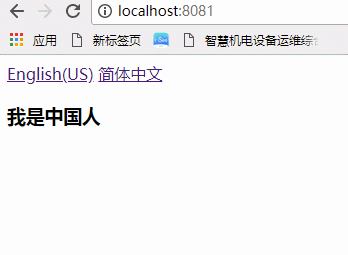从.Net到Java学习第八篇——SpringBoot实现session共享和国际化
SpringBoot Session共享
修改pom.xml添加依赖
<!--spring session--> <dependency> <groupId>org.springframework.session</groupId> <artifactId>spring-session-data-redis</artifactId> </dependency>
添加配置类RedisSessionConfig
@Configuration @EnableRedisHttpSession(maxInactiveIntervalInSeconds = 60)//默认是1800秒过期,这里测试修改为60秒 public class RedisSessionConfig { }
添加一个控制器类SessionController来进行测试
@RestController public class SessionController { @RequestMapping("/uid") String uid(HttpSession session) { UUID uid = (UUID) session.getAttribute("uid"); if (uid == null) { uid = UUID.randomUUID(); } session.setAttribute("uid", uid); return session.getId(); } }
先访问http://localhost:8083/boot/uid

然后修改配置文件application.yml
spring:
profiles:
active: test
重新运行IDEA,test配置文件配置的端口是8085,所以浏览器输入http://localhost:8085/boot/uid

我们看到两个uid是一样的。
在这里我是使用spring boot redis来实现session共享,你还可以配合使用nginx进行负载均衡,同时共享session。
关于nginx可以参考我的另一篇文章:Nginx详解-服务器集群
spring boot 国际化
在spring boot中实现国际化是很简单的的一件事情。
(1)在resources目录下面,我们新建几个资源文件,messages.properties相当于是默认配置的,当其它配置中找不到记录的时候,最后会再到这个配置文件中去查找。
messages.properties
messages_en_US.properties
messages_zh_CN.properties
依次在这三个配置文件中添加如下配置值:
msg=我是中国人
msg=I'm Chinese
msg=我是中国人
添加完之后,会自动将这几个文件包在一块

需要注意的是这个命名是有讲究的,messages.properties部分是固定的,不同语言的话,我们可以在它们中间用_区分。为什么是固定的命名,因为源码是硬编码这样命名的。
(2)新建一个配置文件LocaleConfig
@Configuration @EnableAutoConfiguration @ComponentScan public class LocaleConfig extends WebMvcConfigurerAdapter { @Bean public LocaleResolver localeResolver() { SessionLocaleResolver slr = new SessionLocaleResolver(); // 默认语言 slr.setDefaultLocale(Locale.CHINA); return slr; } @Bean public LocaleChangeInterceptor localeChangeInterceptor() { LocaleChangeInterceptor lci = new LocaleChangeInterceptor(); // 参数名 lci.setParamName("lang"); return lci; } @Override public void addInterceptors(InterceptorRegistry registry) { registry.addInterceptor(localeChangeInterceptor()); } }
(3)在控制器中,我们添加测试用的方法
// i18n @RequestMapping("/") public String i18n() { return "i18n"; } @RequestMapping("/changeSessionLanauage") public String changeSessionLanauage(HttpServletRequest request, HttpServletResponse response, String lang){ System.out.println(lang); LocaleResolver localeResolver = RequestContextUtils.getLocaleResolver(request); if("zh".equals(lang)){ localeResolver.setLocale(request, response, new Locale("zh", "CN")); }else if("en".equals(lang)){ localeResolver.setLocale(request, response, new Locale("en", "US")); } return "redirect:/"; }
(4)添加视图来展示,在templates下新建文件i18n.html,通过#可以直接获取国际化配置文件中的配置项的值。
<!DOCTYPE html> <html xmlns:th="http://www.thymeleaf.org"> <head> <meta charset="UTF-8"/> <title>$Title$</title> </head> <body> <a href="/changeSessionLanauage?lang=en">English(US)</a> <a href="/changeSessionLanauage?lang=zh">简体中文</a> <br /> <h3 th:text="#{msg}"></h3> <h4 th:text="${message}"></h4> </body> </html>
(5)运行查看效果

| 博客地址: | http://www.cnblogs.com/jiekzou/ | |
| 博客版权: | 本文以学习、研究和分享为主,欢迎转载,但必须在文章页面明显位置给出原文连接。 如果文中有不妥或者错误的地方还望高手的你指出,以免误人子弟。如果觉得本文对你有所帮助不如【推荐】一下!如果你有更好的建议,不如留言一起讨论,共同进步! 再次感谢您耐心的读完本篇文章。 |
|
| 其它: |
.net-QQ群4:612347965
java-QQ群:805741535
H5-QQ群:773766020 |


 浙公网安备 33010602011771号
浙公网安备 33010602011771号